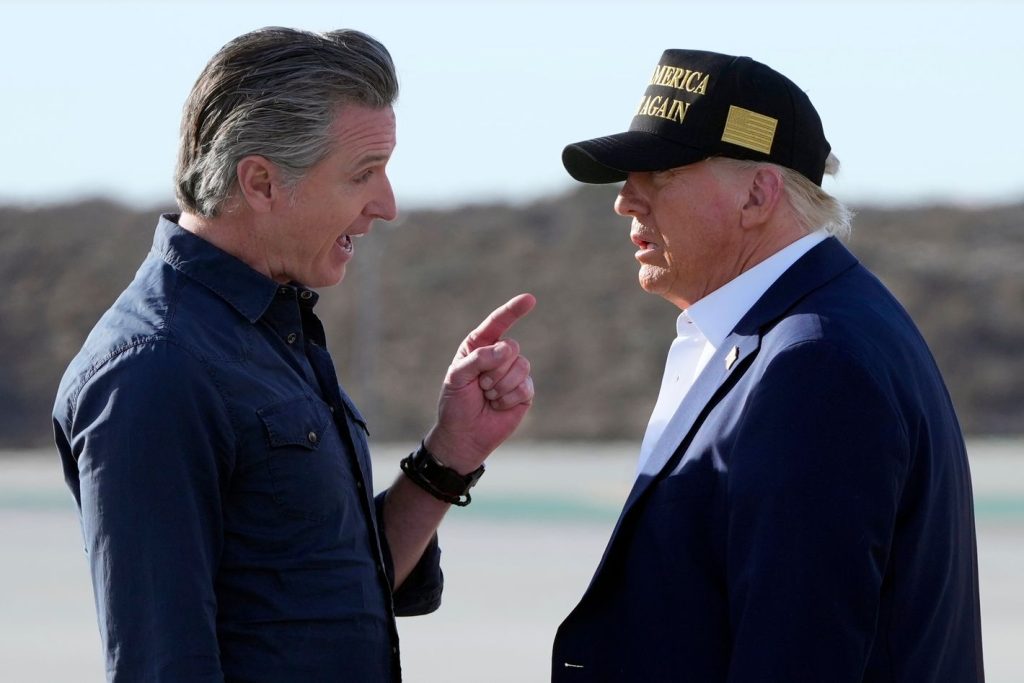Photo: Mark Schiefelbein/AP Photo
One of the big dilemmas facing Democratic governors with not-so-secret White House aspirations is how to exploit intraparty fury at Donald Trump while protecting home-state interests from MAGA retaliation. We recently saw Michigan’s Gretchen Whitmer burn up a lot of her presidential timber by letting Trump get photo ops with her as she pitched funding for a National Guard project in her state. The governor known to have the most extreme case of the White House hots, California’s Gavin Newsom, has gone back and forth between sucking up to the 47th president and blasting him.
Now, Newsom has placed a major bet on cooperation with Trump on an issue particularly associated with the Golden State. One day after the president proposed using his favorite weapon, tariffs, to hit foreign-film-production profitability, Newsom countered by encouraging the administration to work with him to develop a massive new federal tax subsidy for the entertainment industry, as the Washington Post reports:
California Gov. Gavin Newsom (D) is offering to partner with the Trump administration to create a federal film tax credit program worth at least $7.5 billion to boost domestic film production, his office said late Monday. The proposal came after President Donald Trump set Hollywood on edge by calling for massive tariffs on foreign-made films to address what he described as the “DYING” American film industry.
Though Newsom is clearly offering an alternative to Trump’s foreign-film tariffs (partly because they are unpopular in Hollywood), he’s happy to ape MAGA branding for a U.S. film rescue effort:
“America continues to be a film powerhouse, and California is all in to bring more production here,” Newsom said in a statement.
He added that California is “eager to partner with the Trump administration to further strengthen domestic production and Make America Film Again.”
The opportunism of Newsom’s federal-film-subsidy gambit is impressive all right. As the New York Times observes, the U.S. film industry is already awash in state subsidies, mostly extended via transferable tax credits that can be sold for hard cash to boost production-company bottom lines:
[Newsom’s] proposal, if approved, would represent by far the largest single government subsidy program ever for the industry in the United States, and the first of its kind at the federal level. More than three dozen states already give out incentives to lure and retain film and television production, but there is no national program, as is the case in some countries overseas. And there is no single state program that gives out more than about $1 billion each year. California currently allocates $330 million annually.
Indeed, before this latest bid for federal action, Newsom had proposed doubling California’s tax credit to protect Hollywood from both overseas and domestic competition (Georgia, for example, has a much larger subsidy program, and Canada has been competing successfully for film projects for years with its own tax credits). It’s unclear whether a federal credit would benefit California in its domestic competition for film projects, but it could arguably increase the amount of funding for states to divvy up. And Newsom’s not the only Californian thinking this way: According to the Times, Senator Adam Schiff is developing a bill that would create the federal credit in anticipation of a joint Newsom-Trump initiative.
It’s unclear whether Trump will take Newsom’s bait. The president’s unpredictability on boosting the U.S. film industry was made evident with his proposal for a 100 percent tariff on foreign films. Trump’s buddy, the actor Jon Voight, had suggested various industry incentives, but Trump made his plan mostly about tariffs. As The Hill explains, “The plan that [Voight] presented to Trump, along with the actor’s dire assessment of filmmaking in the U.S., calls for ‘tariffs in certain limited circumstances,’ as well as incentives for domestic-made movies.” Trump’s 100-percent-tariff idea isn’t particularly limited.
The broader question about Newsom’s (and Voight’s) federal-subsidy bid is whether it’s a good idea. A host of studies from various states around the country have concluded that the subsidies cost quite a bit more than they deliver, particularly if they are not carefully tailored to encourage long-term development of film infrastructure. Perhaps the most damning analysis was conducted in 2023 by the Fiscal Research Center at Georgia State University, in the very belly of the Peach State’s beast of a subsidy program. It concluded that “for every dollar spent on incentives only 19 cents were returned, in line with other similar studies like one from New York, with a return between 15 and 31 cents.” A Times report on a push in Michigan to create a new subsidy program in 2024 noted the starstruck character of such initiatives:
Outside experts say that the effects of such spending are overstated and that the initiatives are incredibly costly for state governments. But their academic papers are competing against the promises of lobbyists and the allure of Hollywood stars and exclusive parties.
The not-so-technical term for such subsidies is corporate welfare, and an accurate description of the competition for film projects is a “race to the bottom.” Expanding these subsidies from the states to the federal government doesn’t make them less dubious, and extending the competition for government dollars to the whole world doesn’t make the game any less inefficient and borderline corrupt.
If it produces the poisoned fruit Newsom hopes for, the federal-film-credit idea may create some nice, lovey-dovey moments for the California governor and his frenemy in Washington. But at a time when Trump and his congressional allies are hell-bent on slashing funding for federal programs actually benefiting people in need, it would be just another tax giveaway to the White Lotus set.

